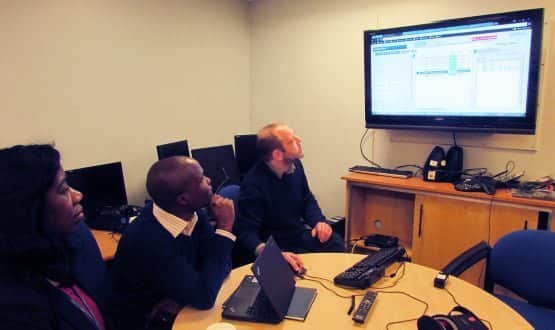Homing in on child protection
- 24 February 2015

Steven Ouko cannot keep the pride out of his voice when he talks about his trust’s work on the new Child Protection Information Sharing system.
“We have had strong leadership, right from the chief executive and the directors… that has given us the driver we really needed to move ahead,” says the systems integration manager.
That pride is well-earned. Last December, Homerton University Hospital NHS Foundation Trust became one of the first trusts in the country to go live with the new CP-IS.
This is designed to flag children identified as vulnerable by social services if they attend A&E or other unscheduled care settings, using information held centrally in a secure database and accessed via the NHS data Spine.
The project, developed by the Health and Social Care Information Centre, will cost £8.6 million over the next five years, and Homerton was chosen as one of the early adopters to lead the way on a national roll-out.
A break from the past
The move to the new system represents a sizable change to the way that Homerton and other NHS organisations have been informed of child protection alerts in the past.
Marcia Smikle, Homerton’s head of children’s community nursing, and the trust’s safeguarding children lead, says past alerts relied on local authorities manually sending through a list of children subject to protection plans.
The trust’s safeguarding team would then place alerts in both the community and acute EPR systems for staff to take note of.
While that approach worked for children who were treated within the borough, it caused problems any time a child was taken into a different area, intentionally or otherwise.
Pauline Grant, the trust’s acting name nurse for safeguarding children, says there have been well documented and publicised abuse cases where parents took their children to out-of-area hospitals to prevent authorities from building a picture of abuse, due to the lack of information sharing.
“With the system now, we’re not totally relying on the parent to disclose the information: when a practitioner turns up to A&E, they’ll see the flag immediately from a local authority.”
Tightly integrated
While Homerton is not the only trust to go live with the new system, it is unique in how tightly it has integrated the alerts into its existing electronic patient record.
Ouko says the trust started working on its plans about 18 months ago, when the HSCIC announced that it would need pilot sites for a roll-out.
After a meeting with the HSCIC’s technical and programme teams, the trust started plotting out its preferred approach to connecting the system with its EPR.
Among the several options discussed were accessing the information via an external portal developed by the HSCIC with NHS smartcard authentication, or a one-click button from the supplier’s system into the CP-IS.
However, Ouko says the trust wanted direct integration with its EPR, so started developing that as another option.
Working with current integration platform supplier InterSystems, Homerton has used the company’s HealthShare software to integrate the child protection alerts into its electronic patient record in a banner at the top of the screen.
Real time on the Spine
As he demonstrates how the CP-IS system works, Ouko says one of its main benefits is that it’s “completely in real time”, preventing unnecessary delays in receiving the alert.
Any time a child attends A&E, an outpatient department or any other unscheduled care setting, their NHS Number is checked via a Spine Mini Service.
If the number cannot be matched, a further trace takes place using other demographics such as the patient’s name, age and gender. If that still does not work, an alert is added to the system for staff to view and take note of.
“As part of the programme, if we fail to trace a child on the Spine, something is wrong and we need to ask more questions,” Ouko says.
Once the NHS Number is verified, the CP-IS database is then queried to see whether there is a child protection plan, a child with safeguarding concerns or an unborn child subject to a protection plan.
If there is, an alert is then displayed at the top of the screen on the patient’s demographic banner, with a different colour and symbol depending on the nature of the alert.
The alert includes details about the type of plan, its length, its start and finish date, the name of the relevant social worker and their contact details.
Staff will also be informed if there is a lapsed protection plan to ensure they can take this into consideration if they have any concerns.
Homerton has also introduced electronic safeguarding forms for staff to submit any concerns they have about a child, allowing the safeguarding team to receive the information quickly and act if necessary.
Staying safe
Since going live, there have been on average more than 2,000 CP-IS queries raised each day, with only a handful of alerts having been registered.
Grant says the process following each alert is compiled into a monthly report for staff to follow through and assess the benefits.
There are also a number of checks in place to ensure that the system is not misused. Every step in the process of a CP-IS check is audited to build up a complete picture of access to the record.
In addition, Grant says all staff are included in safeguarding training, with the level of knowledge required depending on their role.
All staff receive level one training so they have a basic understanding of how it will operate, while clinicians receive more detailed level two training.
Those who come into contact with children as part of their role undertake level three training with information for more complex situations.
Effective, not wonderful
Clinical considerations have been at the forefront of the CP-IS team’s minds during their work on the system.
Ouko says the aim of tightly integrating the new system into Homerton’s existing EPR was to ensure that staff could easily access the alerts, without making burdensome changes to their daily routines.
“Any new system that comes into the hospital, we have to look at how we can best provide information to clinicians.
“We don’t want an extra click or an extra log-on if we can instead pull the information and present it to them in their current systems – that’s why our team exists.”
As Grant says, that ease of use is particularly important given the system’s focus on flagging up alerts for unscheduled care, where staff are already dealing with winter pressures and high demand on A&E departments.
Ouko says that focus on clinical effectiveness was firmly put in place by the trust’s previous safeguarding lead, who worked on the project and sits on the HSCIC’s CP-IS programme board.
“From a clinical point of view, not much was going to change, because that’s what the clinical safeguarding lead was asking for. She said: ‘I don’t want a new system that’s wonderful, I want one that’s effective’.”
The future
Homerton’s success in implementing the CP-IS system is already drawing attention across the NHS.
Ouko says two London trusts have already made contact to arrange a visit and learn more about the trust’s approach, while the HSCIC is working with it to develop case studies about the alerts it has received since going live.
He says this is tribute to the trust’s digital maturity and commitment to tight integration of all its systems.
“We’re very proud of the system – everything is automated, everything is electronic. We have a vision to go paperless, so whenever any system comes in, the question we ask is how can we integrate it with existing systems and best share the information?”
The trust’s work on CP-IS is not over: it is working on an improvement to introduce regular reporting for the safeguarding team, instead of them having to pull out the information into reports.
As the roll-out extends beyond the first wave, Grant says Homerton can also play an important role with other trusts and local authorities, encouraging them to go live by showing them the benefits of the system and the ease of integrating it into daily work.
“With 152 local authorities and 1,200 NHS sites, it’s a huge project and we’re trying to get all of them on board.”





